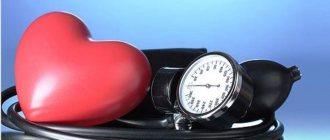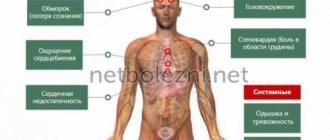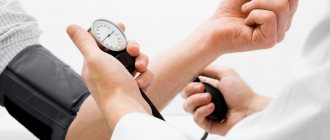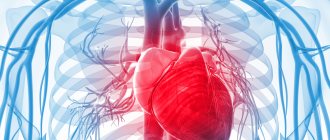Vegetovascular dystonia: symptoms and treatment
The difficulty of making a diagnosis lies in the whole spectrum of symptoms. The disease skillfully mimics; two people with vegetative neurosis can have completely different complaints. However, there are three types of pathology:
- VSD of normotensive type. Characterized by abnormal heart rhythm.
- VSD of the hypertensive type. Characterized by increased blood pressure. The disease carries a risk of stroke, especially in older patients. With this type of VSD, the work of the heart is corrected by reducing heart rate with medication.
- VSD of hypothetical type. Characterized by a decrease in blood pressure. The patient experiences weakness, often fainting. Therapy is carried out with atropine and aminophylline. Along with medications, the patient is prescribed vitamins and medications with antioxidants. Green tea is beneficial.
The first signs of the disease are manifested by the following symptoms:
- From the side of blood vessels and the central nervous system.
Increased heart rate, headache and tinnitus, unusual sweating, muscle pain and trembling throughout the body, including the limbs.
- From the mental point of view.
Panic and obsessive states, sudden changes in emotions, anxiety and suspiciousness.
It is impossible to cover all the signs within the scope of this article (there are more than 150 of them). But our goal is not to make a diagnosis online. If you notice the first alarming symptoms, consult a doctor. The main thing is to be wary of VSD and understand that the disease can manifest itself with a whole range of symptoms.
Vegetative-vascular dystonia: which doctor should I contact?
What are the causes of its occurrence, and which doctor should you contact to receive comprehensive treatment?
Degree of disease development
Depending on the severity of VSD, it is customary to divide it into the following stages:
- Initial. It is characterized by mild pain in the heart that occurs after emotional experiences or physical exertion. Exacerbations do not occur often.
- Average. The duration of periods during which exacerbation occurs increases.
- Heavy. Pronounced symptoms of the disease are almost always present. A rapid heartbeat is often observed, accompanied by PA (panic attacks).
Causes
The primary causes of the disease, as reported by the portal https://lechusdoma.ru/zabolevaniya/, may be associated with damage to the central nervous system of the child still in the womb. As a rule, this occurs in late pregnancy or directly during labor. In addition, VSD can begin to develop in children who live in an unfavorable family atmosphere, have problems communicating with peers, and also often experience stress, physical and nervous fatigue.
As for secondary causes, they manifest themselves as a result of pathological changes in the digestive, endocrine, nervous and cardiovascular systems, which are chronic. In addition, the development of VSD can be caused by a change in climatic conditions, addictions, allergies, poor diet, vitamin deficiency, frequent stress, depressive states, as well as spinal injuries and osteochondrosis.
Which doctor should I contact?
If there are signs of VSD that persist for 2 months or more, you should first visit a general practitioner and a cardiologist. An initial examination by these specialists will show whether the help of an endocrinologist, psychiatrist, ophthalmologist, gastroenterologist, neurologist, surgeon or ENT specialist is needed. Since only a highly specialized doctor will be able to correctly identify the problem and prescribe treatment that eliminates the cause of unpleasant symptoms.
Treatment of VSD is quite complex, so an integrated approach is required, including taking medications, normalizing sleep and daily routine, exercise therapy, water procedures and massage. Moreover, most patients notice improvements precisely after adjusting their diet, daily routine and giving up bad habits. In other words, lifestyle changes often help get rid of the symptoms of the disease.
What will help with the diagnosis of VSD
Have you passed all the necessary examinations and have not found any somatic diseases? In this case, we are talking about a neurotic condition that could develop as a result of stress or excessive fatigue of the body and psyche. In fact, you are healthy, but you need to stabilize your psyche and help yourself recover.
What methods would be appropriate
:
- Visiting a psychologist and psychiatrist to monitor dynamics
- Organized work and rest schedule
- Healthy sleep pattern - at least 7-8 hours
- A healthy diet that includes a large amount of vegetables and fruits, vegetable fats (oils, nuts), fish and seafood, cereals, lean meats, dairy products.
- Moderate sports activities - walking, yoga, stretching, exercise therapy
- Relaxation techniques - meditation, taking a warm bath with sea salt and aromatic oils
- Reduced overall stress levels
Causes of a panic attack
It is important to understand that the idea that panic attacks are 100% related to mental disorders is completely wrong. Yes, such a symptom can be explained by various mental disorders - for example, it occurs in low-grade schizophrenia, and often accompanies hypochondria or neuroses of various types. It also accompanies some types of depression. But it doesn't stop there. Sometimes panic attacks are atypical manifestations of somatic diseases, and in this case, doctors do not immediately connect one with the other.
Situations are very common when a symptom is explained by the presence of neurological disorders. This may be a disorder of the vestibular apparatus or some organic diseases of the brain.
A panic attack can be triggered by stress, accumulated fatigue, and the use of certain psychoactive substances. But all these are external factors that do not cause the problem on their own - they only stimulate it, pull it out from within, when it already exists against the background of the problems listed above.
After the first panic attack occurs, a person begins to return to this state again and again. The situation is aggravated by the fact that the very memory of this condition and its anxious anticipation contribute to the recurrence of attacks.
Why this particular diagnosis?
In the distant USSR, people were forbidden to engage in psychology and psychotherapy, since only psychiatry existed. It was because of this that doctors turned a blind eye to patients’ complaints in the field of neurotic problems, which is why the latter became delusional about their “illness.”
Since with neurosis the vegetative system necessarily suffers, the first part of the word VSD will be “Vegeto”. With cardiophobia or tachycardia, a person fears for his heart - hence the name “vascular”. And “dystonia” means a violation of something. As a result, if we speak in clear language about VSD, then we get “Problems with vegetation and blood vessels.” In fact, this is, of course, complete nonsense. What is neurosis?
These are characteristics of a person’s character and worldview. If he is faced with life circumstances that fundamentally contradict his childhood beliefs, then this person develops more and more stress. And when this tension goes beyond all boundaries, then the same “VSD” occurs - that is, suppressed emotions enter the body, and the symptoms we all know begin.
Lifestyle during panic attacks
It is important for people who suffer from such symptoms to remember that they do not go away on their own—the situation will only get worse over time. At the same time, each time the body will experience enormous stress - an untimely sense of danger forces it to work at “maximum speed”. The sooner the patient begins a thorough examination and, with the help of doctors, discovers the causes, the less risk there is of aggravating the situation and causing additional illnesses.
Contact the Kuntsevo Treatment and Rehabilitation Center - they will help you!
Symptoms of the disease
VSD, in essence, consists of a violation of control over vascular tone. Common symptoms and changes associated with this include:
- sweating, “hot flashes” (feelings of heat), chills;
- tachycardia, bradycardia;
- chest discomfort, pain;
- sudden changes in blood pressure;
- dizziness, loss of consciousness;
- increased breathing, feeling of lack of air;
- headaches, migraines;
- neck pain;
- disturbances of cognitive processes (memory deterioration, decreased concentration, etc.);
- fatigue, drowsiness, weakness;
- numbness of hands, feet, feeling of goosebumps;
- redness of the skin at the slightest mechanical impact or, on the contrary, marbling of the skin at rest;
- intermittent, shallow sleep;
- abdominal cramps and pain, bloating, loss of appetite, nausea;
- decreased libido in men and women of reproductive age.
Vegetative-vascular dystonia can be an independent disorder or a signal of the presence of other pathologies: liver diseases, biliary dyskinesia, intestinal microflora disorders, gastrointestinal diseases, etc. This is most often associated with the production of toxic products that affect the state of the nervous system. In addition, when prescribing treatment for VSD, it is important to remember that allergic diseases, endocrine diseases, changes in hormonal status, etc. can lead to the disease. Therefore, other signs may be added to the symptom complex. This often makes diagnosis difficult, but if you contact an experienced, qualified specialist, he can cope with this task.
Why don't other people have this problem?
Because every person has their own childhood and upbringing. And the tougher it is, the greater the likelihood of “getting sick” with neurosis. I'll give you an example to make it clear to you.
Let's take two identical families. In the first, parents forbid their daughter to: go out after 18:00, have sex before marriage, drink alcohol, smoke, go to her favorite institute, communicate with strangers, bring guys to the apartment, dress at her own request, and eat her favorite food.
If such a very limited girl, when separated from her parents, begins to lead a completely opposite lifestyle - that is, to go against her parents, then an internal conflict will arise between her beliefs and circumstances. That is, on the one hand, she wants to live as she pleases, but on the other, she is afraid of offending and receiving the anger of her parents. Emotions are suppressed, tension increases - and then one fine day your favorite “VSD” begins.
In the second family, the parents allowed their daughter to live as she wanted. They taught their child a rational life, talked about their experiences, but never imposed anything of their own. Such a girl will never enter into an internal conflict, and accordingly, neurosis does not threaten her. And, therefore, she will never have “VSD”.
The importance of timely treatment
Treatment of dystonia in many cases is a mandatory measure, since this disorder can be complicated by vegetative crises. Despite the fact that this complication occurs on average in one in ten patients, severe symptoms that reduce the quality of life are also indications for therapy.
The crises are as follows:
- sympathoadrenal: based on a sharp release of adrenaline into the blood, which leads to spasm of blood vessels, headache, increased heart rate, chest pain, panic attack and severe fear;
- vagoinsular: insulin is released into the blood, which leads to a sharp decrease in glucose levels, characterized by a decrease in heart rate and a decrease in blood pressure;
- mixed: there is a combination of symptoms.
The result of VSD, which has not received enough attention, can be arterial hypertension, tachycardia, arrhythmia, neuroses, cholelithiasis and disorders of the gastrointestinal tract, etc. A person’s social life may suffer: he experiences difficulties at work and in communicating with others, due to the frequent manifestation of symptoms, he cannot cope with professional and other responsibilities. Therefore, complex treatment of VSD is indicated for virtually everyone who in one way or another suffers from manifestations of the disease.
I don’t believe that I feel so bad, and it’s all because of my character!
Of course, it is more profitable for you to believe in some abstract disease. Firstly, this occurs due to ignorance of the problem with neurosis. And secondly, it is much easier for you to shift responsibility to doctors and doctors, and most importantly, to some mysterious disease, than to start working on yourself.
You feel so bad because you have accumulated so many suppressed emotions that they are constantly being released into your body. You may not notice these emotions because this is the main task of neurosis - to make you pay attention only to your bodily symptoms! So you may be surprised that the whole problem is your character.
How to get rid of VSD?
First of all, it is necessary to understand that such a diagnosis does not exist. You will not find these three mysterious letters in any International Classification of Diseases. Therefore, you have nothing to get rid of.
But if we talk about neurosis, then here you will have a lot of work. The first is to improve the emotional part, the second is the behavioral part, and finally the physical part. And all this is done by none other than a good and competent psychotherapist. Unfortunately, in Russia there are very few truly qualified specialists in this problem.
You can run around dozens of doctors. Therapist, cardiologist, endocrinologist, pulmonologist, neurologist, psychiatrist - this is the usual chain where a person begins when faced with the problem of neurosis. (Not VSD!) But all these doctors can do is tell you that you are absolutely healthy, but you probably have VSD, and you need to drink motherwort and valerian.
That is, vegetative-vascular dystonia is a pure kind of symptoms and a consequence of a huge neurosis. It's like a fever with the flu - just one tiny component of a big disease. Only, unlike the flu, neurosis is not a disease, and it cannot be treated. But you can work on neurosis with a psychotherapist, because this is work on character! And it will depend solely on you and your personal trainer.
Types and symptoms
In medical practice, VSD is divided into:
- cardiological type. Shortness of breath, sharp or dull pain in the chest, rapid heartbeat,
- tachycardial type. Vibration is felt in the vessels, the pulse quickens, the face turns red, the pain in the temples progresses,
- hypertensive type. The heart rate increases, blood pressure rises, legs go numb, chills are felt,
- visceral type. The pain is localized in the intestines and abdomen, there is a feeling of fullness, constipation or diarrhea appears,
- hypotonic type. Weakness, shortness of breath, nausea, sweating and low blood pressure are the main signs
- asthenic type. Characterized by fatigue, decreased stamina, loss of attention, trembling hands,
- respiratory type. You feel a lump in your throat, there is not enough air, there is a pressing pain behind the sternum,
- mixed type.
Exacerbation of VSD occurs sharply due to stress, poor nutrition, depression, hormonal imbalance, chronic diseases, etc. These symptoms are accompanied by severe unbearable pain.
Causes
According to most doctors, in order to cure vegetative-vascular dystonia, it is necessary to find out the cause. It is possible to identify the main factors that influence the development of this disease. The most basic reason is heredity. That is, if one of the close relatives, such as mother, father, grandmother, grandfather, aunt, suffers from migraines, often faints, or experiences dizziness, then there is a very high probability that this is a genetically determined disease. And this is connected with the vascular and nervous system.
The way a person’s intrauterine development took place also matters and is reflected later on the child. The environment in which the child grew up is also of great importance. The child should live in a positive, calm environment. But, unfortunately, this does not always happen. Quarrels and scandals in the family are quite common occurrences that lead to additional stress on the child, even to the point of a nervous breakdown. These factors significantly influence the child’s autonomic and vascular system and also underlie the development of vegetative-vascular dystonia.
Another critical period is puberty. It is known that active hormonal changes in a growing body are often accompanied by disorders of the endocrine system. This is stress for the body: in fact, when the thyroid gland, adrenal glands, and sex glands do not have time to keep up with the rapid growth and development of adolescents, the autonomic nervous system is overstrained. If you understand in time that the child is prone to the disease and take all necessary measures to limit the burden on the child, then there is every chance to stop the development of vegetative-vascular dystonia.
Diagnostic features
The main difficulty in diagnosing VSD is to find the true cause of the disorder: a disease or disorder that has led to inadequate control of vascular tone by the nervous system. However, when contacting a neurologist, he will first find out your medical history, as well as lifestyle features.
In the event that there is non-compliance with the daily routine or bad habits, the primary recommendation would be to normalize the rhythm of sleep and wakefulness and maintain a healthy lifestyle. If the situation does not improve within a few weeks, it is important to look into the problem in detail.
It is necessary to exclude organic diseases of the nervous system. This may require various methods: from CT of the brain and EEG to ultrasound examination of the vessels of the neck. It is important to undergo laboratory diagnostics (blood tests, determination of hormone levels) and consult an endocrinologist and cardiologist.










